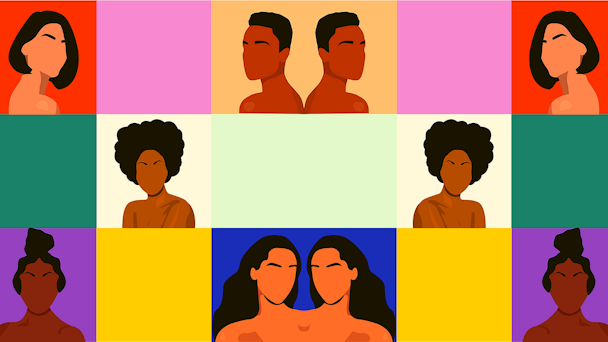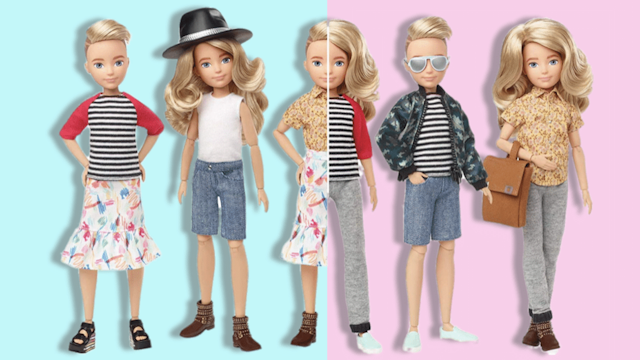
Advertisement

The future is fluid: the dawn of gender neutral branding
More consumers than ever are comfortable expressing personal identities beyond the gender binary. As the conversation evolves, will 2021 be the year that brands fully embrace gender neutral branding?
“Amen and a-woman,“ intoned US congressman Emanuel Cleaver, as he closed the opening prayer delivered on the first day of the 117th US Congress on January 3. He deemed the line light-hearted and inclusive – but instead, his gesture of gender neutrality provoked tough criticism, beyond the grammatical issue with his phrasing (’amen’ is not a gendered word). In 2021, people are really sensitive when it comes to gender.
The skirmish around Cleaver’s address followed a year that saw public conversations around gender focus on JK Rowling’s Twitter feed and a sensational edition of Vogue that had some US conservatives fuming at cover star Harry Styles for the threat he posed to 'manly men'.
There is no society that can survive without strong men. The East knows this. In the west, the steady feminization of our men at the same time that Marxism is being taught to our children is not a coincidence.
It is an outright attack.
Bring back manly men. https://t.co/sY4IJF7VkK
— Candace Owens (@RealCandaceO) November 14, 2020
"In 2020, there was a noticeable shift away from societal gender norms, with the conversation around breaking down gendered barriers becoming more mainstream," recalls Alex Ehmcke, chief operating officer at PinkNews. "The problematic nature that society puts on traditional gender norms isn't a niche anymore - it's becoming part of the conversation." In UK’s largest ever survey of its LGBT+ population, carried out in 2017, 6.9% of those surveyed identified as non-binary; Stonewall estimates that perhaps 1% of the British population identifies as trans or non-binary. Miley Cyrus and Cara Delevingne are among the notable names that identify as gender fluid, while Queer Eye star Jonathan Van Ness and singer Sam Smith both identify as non-binary. So both private individuals and public figures now feel more confident with these identities – and if there wasn’t a commercial case for gender neutral branding before, there is now. “The appetite for gender neutral branding has been here for some time,” insists Asad Dhunna, founder and chief exec of The Unmistakables, a diversity-led consultancy. “The difference now is that people understand the negative effects of gendered branding so much more, and they’re not willing to accept it. Gender neutrality is becoming increasingly expected.“
With the non-conforming world evolving and public appetite for gender neutral branding growing, particularly within the hygiene, beauty and clothing industries, some brands have risen to the challenge – whether by reframing their copywriting, introducing gender neutral product lines or retuning their strategy entirely. Last year saw Levi’s offered its first genderless foray with an ‘Unlabeled’ collection. It leant on market research that indicated 30% of Gen Z Levi’s fans shop across genders. Recognising that it did not have a genderless concept for the brand at the time, it asked its grassroots group of LGBT+ employees to curate a homegrown, gender-less collection from its existing line.
“We didn’t know this would work. We hoped it would, we thought we would, but we didn’t know until we saw the results,” admits Peter Lewin, senior director of strategy and marketplace insights of Levi’s Unlabeled. “It’s been validating that Levi’s fans have embraced not only a genderless collection but also one that’s such an authentic expression of our values and who we are.” Yet, while Levi’s saw success, when it comes to the gender debate, things do get a little heated for brands. In the wake of JK Rowling’s infamous tweet, the Body Shop faced calls for a ‘boycott’ when it chose to wade into the ’people who bleed’ discussion by tweeting a photo of a red canvas that read: “It’s bloody natural. #DropThePWord to end period shame.“
Hey @jk_rowling here's something we made earlier, we thought you might like one! We've also popped in a vegan bath bomb and a copy of Trans Rights by @paisleycurrah for you to read in the bath! pic.twitter.com/RNbPsSTS88 — The Body Shop (@TheBodyShop) June 10, 2020
Similarly, tampon brand Tampax was criticised in October by people who argue that only biological women experience periods, for an inclusive tweet that “celebrated the diversity of people who bleed“.
It’s crucial that brands understand their audience before wading in. “If you’re introducing gender neutral branding to a product line to adhere to the values of your audience, ensure that these values are reflected within your organisation,“ insists Dhunna. “Make changes for the right reasons. Prodding the right-wing in what appears to be a PR fling won’t have a lasting impact and could backfire, so it’s essential that you can back up why developments have been made.“
Just 20 years ago, Nestlé-owned Yorkie launched its aggressively macho campaign ’It’s Not For Girls!’ accompanied by lines like ‘Man fuel for man stuff’, ‘Not available in pink’ and ‘Don’t feed the birds’. Strong marketing, considering the sole object was to sell five solid chunks of chocolate, interspersed with raisins and biscuit. The campaign ran until 2012.
Advertising has a long history of egregious gender stereotypes and many audiences will take a long time in forgiving the medium. So, how can brands enter the space in a way that doesn't feel tokenistic?
“Gen-Z are looking for increased transparency in the companies they buy from, and will call out those who aren’t living up to what they preach,” advises Ryan Sherman, senior creative, at Virtue Northern Europe, where he helped launch Q – the first gender neutral voice for AI.
“Attempting to profit from gender-neutrality without a genuine effort to adopt the thinking into your own culture will show. Putting in the effort to hire, work and produce with people across the gender spectrum should be the first step before entering this space.“
Whembley Sewell, chief editor of the Condé Nast LGBT+ mag, Them, insists brands should be intentional. “I would hope that brands understand gender neutral design is not simply a trend or a way to pander to certain demographics or a means to streamline production.”
She explains that what most brands fail to consider is that gender-neutral doesn’t mean products or creative should be devoid of gender expression, or strictly masculine-as-default. She says, “in my humble opinion, products and collections that are truly ‘gender-neutral’ should embrace the gender spectrum.“
Slowly but surely brands are realising the negative effects gendered branding can have on their potential customers. But beyond beauty, hygiene and clothing, what sectors could make their offering more inclusive?
“Gender neutral greeting cards appear to be making an appearance on sites such as Etsy, and it’s only a matter of time until the mainstream catches up – particularly when it comes to cards for children,” says Dhunna. He also points to the food and retail sector, which has started revamping the shopping experience through a gender neutral lens. The Co-op, for example, now offers a ‘Gingerbread Person’ from its bakery.
Sewell says she’s hoping to see changes when it comes to the products that shape the lives of children. “With play being so formative for young people and their understanding of self, it does give me hope to see how companies are reorienting how they create toys and early education products,” she insists.

Indeed, after facing years of criticism for projecting an idealised version of female beauty with its Barbie doll, Mattel introduced what it billed as the world’s first ‘gender neutral doll’ last year.
“Toys are a reflection of culture and as the world continues to celebrate the positive impact of inclusivity, we felt it was time to create a doll line free of labels,” explains Kim Culmone, senior vice president of Mattel Fashion Doll Design.
“Through research, we heard that kids don’t want their toys dictated by gender norms. This line allows all kids to express themselves freely which is why it resonates so strongly with them. We’re hopeful Creatable World will encourage people to think more broadly about how all kids can benefit from doll play.”
Considering the progress that was made in 2020, will brands fully embrace gender neutral branding this year? “Not even close,“ says Sherman. “Brands have been marketing by gender since they noticed women bought things too. Over time, as notions of gender have changed, brands have kept roughly apace. But we are in the midst of a bigger shift than ever before. The generation coming into adulthood today is ripping up the binary.”
While there's still a long way to go, Dhunna suggests that 2021 will be the year that brands reassess some of the fundamentals of marketing, questioning the characteristics such as gender that has so often been the starting point for audience segmentation. “I think brands are seeing more proof that being gender neutral widens its reach and improves their reputation,” he insists.